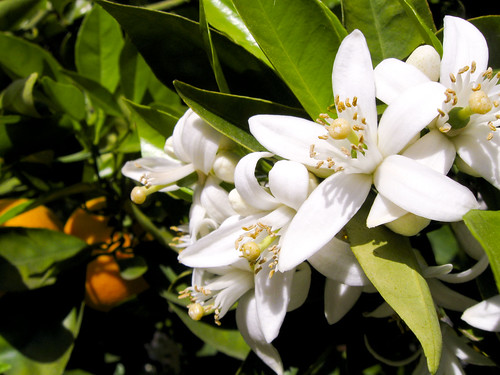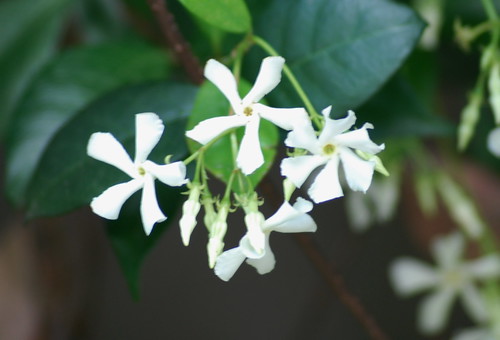The Bitter Orange Tree, Citrus aurantium var. amara, gives us so many fragrant gifts: Neroli, Petitgrain, Bitter Orange essential oil, and Orange Blossom Absolute. To my mind, it’s a tree of wonders.
I needed to select a Neroli oil for a recent project, and so bought the Neroli & Orange Blossom Sampler Pack from Eden Botanicals. Convenient! Here are my notes.
- Neroli, Egypt – A very earthy Neroli. It still has the fresh, green, crisp, sharp character of the scent – there’s no mistaking it – but there is a heaviness here. Not the lush heaviness of the indolic flower, but rootier with a little smoke – more like Vetiver. Also a powdery quality, almost like Orris. How unusual for Neroli! As it drys down, something about this makes my head go, “wet dog.” Ha! Wonder why? On closer sniff, it’s a note of intense green-orange bitterness. Foliage. But I still can’t shake the “wet dog” association.
- Neroli, Egypt, Organic – At first, almost indistinguishable from the first one. Same rooty/earthy quality, more complex but far less intense.
- Neroli, Morocco, Organic – Sharp, green, fresh, with a bitter top note – straight-up, classic Neroli. Reminiscent of Petitgrain, but lighter and more floral. Overall strong, bold character for a Neroli with excellent tenacity for this material. Nicely unisex. A touch of lime. All-around winner!
- Neroli Extra, Tunisia – Another classic Neroli. Prettier, more floral than the Moroccan. Soft, delicate, by comparison. As it warms on the skin it becomes much sweeter. Pretty with a sprinkle of sultry. Another winner!
- Neroli, France – Ah, this one makes me sigh and flutter my eyelids! Most delicate creature of all, ethereal and fairy-like, but still with that classic Neroli sharp/green/dry/bitter profile. It’s sweeter than most, but not as sweet as the Tunisian. It might be fun to blend the two for the perfect femme Neroli note? Drawback: Extremely fleeting. But so pretty and innocent!
Now for the orange blossom…
- Orange Blossom Absolute, Egypt – Dark green viscous liquid. Yea gods – NO, I do not like this. Dark green, and at first smells green, dank, musky and of vegetable rot to me. As it dries out, it lightens a bit and smells heavy and spicy. Others have waxed poetic about its sensual quality. It is likely that I need to smell this very diluted – then perhaps I’d have a better appreciation for its character. Sniffed straight up, however, it makes me want to run for the hills! My body vibrates with, “NO!” I keep sniffing anyway, trying to understand it, but this one is tough for me to love. That said, I think this might blend beautifully with Sandalwood or other woody/spicy notes. Okay, as this warms up, it’s growing on me. Strikes me as a masculine, powerful, spicy, and sensual floral. Not my style, but an intriguing and powerful note. Okay fine, I’m fascinated. What IS this stuff?! So complex. There’s another weird, almost herbal-leathery facet happening here. Never once have I thought “floral.” This might smell amazing on a man. Spice, spice, and more spice. And sweet leather. Wow! DARK SEXY ORANGE BLOSSOM.
- Orange Blossom Absolute – Fine, Morocco – Eek! Double the price of the first one, but this is the one I bought blind, unsniffed, before getting the sampler pack. Lesson learned. Dark amber-orange viscous liquid. Again with a nasty green rotten vegetable top note, though not as instantaneously off-putting as the Egyptian. I have experimented with this one in a couple of perfume blends, and I find that the green note lingers, and goes “tobacco-y” in compositions, at least to my nose. This is one reason it works so well in the Orange Blossom-Tobacco solid perfume. As it dries down, it becomes a very rich green-white floral note. The rotten compost nasties linger too long for my taste. Again, this stuff is so powerful I probably should be smelling it diluted. Maybe I just don’t know how to work with it properly, and it can only be used in trace amounts. Or maybe next time I should buy the Egyptian? I try and try to like this but am disappointed. Tenacious stuff though, I’ll grant it that.
- Orange Blossom Organic Extract – Spicy food. What on earth? This has a pungent, earthy, spicy aroma that makes me think of some Asian dish that I can’t quite put my finger on. Very warm and deep. Cooked / stewed citrus vibe. Smoky? The material itself is viscous dark brown liquid. No harsh green notes! The organic extraction method (no hexane) means it’s safe for therapeutic uses and even food. The tenacity on this is pretty incredible, and several hours later it’s morphed into something animalic, rich and musky. Weird. Wonderful.



